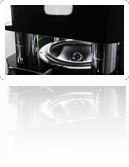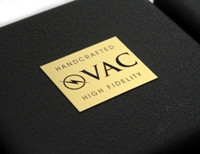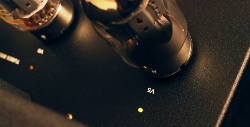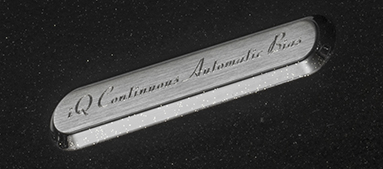|
|
VACIntroduzione  Sito web: http://www.vac-amps.com Sito web: http://www.vac-amps.com Torna all'inizio
The VAC iQ Intelligent Continuous Automatic Bias System Traditional theory gives feedback high marks, but this analysis changes when we consider that the "error" signal is fed back into a non-linear amplifier that makes mistakes (otherwise there is no need for any error correction). Due to this, feedback may lower the overall level of distortion products, but it also multiplies the order of the distortion products. For example, if an amplifier naturally produces second harmonic, feedback will create a second harmonic of that second harmonic, which is the fourth harmonic. If the basic amplifier has second and third harmonic distortion products, the fed-back amplifier will contain second, fourth, sixth, and ninth. As is well known, the higher orders of distortion are more objectionable to the ear than lower orders, and odd orders more offensive than even orders. Thus it is possible to lower the level of distortion products and yet make the distortion more audible and offensive to your ear. The application of negative voltage feedback also reduces an amplifier's measured output resistance, i.e., it raises the "damping factor." Here again, the measurement fails to capture the essence of things. In the case of a feedback amplifier, better control of speaker motion is said to occur because the speaker's excess motion creates a voltage (the back e.m.f.) which enters the feedback loop via the amp's output terminals. The amplifier then acts in a manner opposite the error signal to correct for it. However, like many theories, this is an oversimplification and, in practice, the opposite result may be obtained. There are several reasons: 1) The motion of a speaker's voice coil former may not match the acoustical output due to cone break-up modes and room acoustics. 2) The motion of the coil former is being sensed by the voice coil. The coil is designed to be a good driver, but is a lousy sensor, primarily due to its high inductance, which will create phase anomalies in the back e.m.f. 3) The back e.m.f. may pass through a cross-over network, which will again alter phase and frequency relations. 4) A differing back e.m.f. from another driver may be summed in via the crossover, making a composite signal that does not match either individual driver. 5) The speaker leads may cause additional phase shifts. By the time the error signal reaches the power amplifier, it is arguably an erroneous error signal. As the power amplifier attempts to correct for this signal, it may actually do the exact wrong thing with respect to the speaker's acoustic output. Subjectively, I have noted that high feedback amplifiers tend to give the bass a "one note boom" on certain speakers, and tend to create an electronic glaze in the midrange, possibly attributable to this process. With regard to damping, we believe the best approach is to design the amplifier to have as low an output resistance as possible in a static sense and use little or no feedback. As we often say, in a battle between theory and the real world, the real world always wins. To state the obvious, a single-ended circuit must be Class A1 or A2. A push-pull amplifier may be Class A1, A2, AB1, AB2, B1, or B2. Class A indicates that each output tube handles the full cycle of the audio signal, while AB and B allow some of the devices to cut-off during a portion of the cycle. Subscript "1" indicates that no grid current is drawn by the output tube, while subscript "2" indicates that the output stage enters the grid current region of operation. In the grid current region, the impedance presented to the driver stage is abruptly lower, and drive power is required, not just drive voltage. The grid current region tends to be rather non-linear, and most designers will avoid it. Single-ended and push-pull circuits may be built with triodes, beam power tubes, pentodes, or the latter two in ultra-linear ("partial triode") mode. In a Class A push-pull circuit, there is a natural cancellation of even-order harmonic distortion products. The cancellation is not complete, of course, but it would be unusual to see large amounts of second harmonic distortion from a push-pull circuit (Radiotron Designer's Handbook, 4th ed., 1954, page 571). Applying this to the Renaissance Series, the circuit is strictly Class A1, and is push-pull with the exception of the very first 6SN7 triode, which operates under conservative conditions and is thus relatively free from distortion (Moir, High Quality Sound Reproduction, page 264). This single phase splitter triode is interesting, in that the very same electron current flow creates the antiphase push and pull signals, which, given equal impedances within the amp (they are), match exactly. As such, the signal is not being Cuisinart-ed as with most phase invertors, an objection voiced by many single-end advocates. Note that a push-pull circuit has no significant ability to cancel odd-order distortion products. If low distortion performance is required, one must avoid the generation of odd-order harmonics in the first place. A good triode tube meets this requirement. Three difficulties are encountered in the design of a single-ended tube power circuit. Firstly, there is no mechanism to naturally cancel even-order harmonic distortions. Secondly, significant new distortions may arise in the output transformer. Thirdly, available power output is greatly limited in a single-ended design, such that it will be spending more of its time in overload for a given volume level. For background, recall the old children's science project in which a length of wire is coiled around a nail and then connected to a battery. The DC current from the battery flows through the coil to create an electro-magnet. The primary winding in a single-ended output transformer is similar to this, and also creates an electro-magnet. The full DC current for the output tube(s) flows through the transformer primary and strongly magnetizes the core of the transformer. Thus, much of the core's ability to couple the audio signal is used up by the non-audio DC current, and causes the core to saturate asymmetrically with audio signals (Radiotron, page 247). Even below saturation, this DC bias increases distortion, especially at low frequencies (Moir, page 283; Radiotron, page 217). Adding parallel output tubes for more power directly increases the DC magnetization current, thus exacerbates the distortion problem, and requires that more primary inductance be designed into the output transformer. To deal with this, a less saturable core alloy is often used, but this causes poorer coupling of the audio signal (Radiotron page 207). Alternately, a large "air gap" may be introduced into the transformer geometry, which again causes aberrations in coupling. In most cases, a greater amount of core material is used, which may in turn increase some low level (B-H) non-linearities. The final result is either a higher degree of distortion (all harmonics with the second dominating, increasing with decreasing frequency), a measurably peaked frequency response, or both. Radiotron summarizes, "...fairly high distortion has the effect of apparently accentuating the bass...It should be emphasized that this is not the same as true bass, and does not constitute fidelity" (Radiotron, page 616) and notes that this trick was used "In small [radio] receivers, in which the loudspeaker is sometimes incapable of reproducing the bass" (Radiotron, page 676). Since the distortion in the single-ended transformer is asymmetrical, a system based around this type of amplifier might be more sensitive to absolute polarity. In a fairly complete summary of single ended output transformers, Duncan Kelly concludes, "Direct current is thoroughly undesirable in audio transformers" (Transformer Distortion, Audio, March 1959, page 44). These problems do not arise in a push-pull amplifier, in which the primary halves are oriented in opposing DC directions (Moir, pages 282-284; Radiotron page 207). The DC magnetization force is thus canceled and is not an issue unless the push and pull output tubes are adjusted to draw different currents. Any imbalance in DC idle current will lead to greater distortion at low frequencies, just as in a single-ended design (Audio Cyclopedia, 2nd Ed., 1969, pages 1449-1450). The Renaissance Series maintain a high degree of DC balance due to the self-correcting nature of 300Bs under individual cathode bias. Please note that the distinction between push-pull and single-ended Class A triode designs does not stem from the tube itself, but from the natural distortion cancellation in push-pull and from the transformer problems in single-ended. Since a single-ended transistor amplifier may omit the output transformer, it may display yet another set of characteristics. How the ear deals with the characteristics of a single-ended tube power amplifier is quite interesting. The human ear is a non-linear encoder of information, and excess second harmonic blends in to form the impression of an additional sub-harmonic. This technique was deliberately employed in small radios in the 1940's to create a richer sound, then referred to as "synthetic bass" (Radiotron pages 616, 676). The Radiotron Designer's Handbook notes, "It should be emphasized that this is not the same as true bass, and does not constitute fidelity." The frequency response errors of some single-ended tube amplifiers tends to create a high frequency boost and a low frequency cut, in one case approximately +/- 3 dB (Stereophile, Jan. 1994, page 108). The subjective effect of the low frequency loss might perhaps be partially offset by the second harmonic distortion. Earlier I noted that the triode could be the most linear of amplifying devices. I left this small hedge because it is possible to build a rather flawed triode as well. The 300B is a highly linear tube. In fact, the high voltage supplies in the Renaissance Seventy/Seventy do not vary by one volt over the range from idle to clipping, indicating an absence of rectification effect (distortion). The type 845 is also a very linear tube, although requiring higher drive voltages, which can result in more overall distortion. The 211 is a bit more problematic; it requires a large drive voltage and drive power to deliver full output. In such operation (Class A2) the tube is said to "draw grid current." Entering the grid current region may cause a sort of crossover behavior as the driver stage is abruptly called to provide significant power into a suddenly lower impedance load (Moir, page 281; Ravenswood, Fixed Bias, Audio, Feb. 1958, page 48). Amplifiers running subscript 2 operation often may be identified by the use of a power tube (2A3, 300B, etc.) in the driver position. The 211 and 845 also require very high plate voltages ( 800-1200 VDC 800-1200 VDC ), about twice that of the 300B, and desire a higher load impedance, both of which complicate output transformer design. It has been asserted by some contemporary designers that one can not hear second harmonic distortion of 10% to 20%, such as may be produced by some single-ended tube amps. However, I find no corroboration of this, and in the Renaissance Seventy/Seventy hold the sum of all harmonic distortion, including the second, to approximately 2% at clipping without negative feedback. It is also worth noting that multi-grid tubes, such as the KT88, connected as triodes often do not exhibit linearity comparable to the 300B, 845, or 211 tube types, although this connection may have some advantages over traditional pentode/beam power operation. In any event, I do not think that THD as such is actually what we hear. I believe that it shadows something that we do hear in the context of analogue tube equipment. As a case in point, there was a 1987 Journal of the Audio Engineering Society (JAES) publication of a study by Dolby Labs' Louis Fiedler, in which, if memory serves, .005% THD in a digital system was clearly audible to all listeners. Several times this amount would not be detectable in a similar tube analogue set up. Some other measurement likely will be found significant in the context of the a/d/a cycle, and will probably be meaningless when applied to tube amplifiers. At the end of the day, the human auditory system is a marvelously arcane recognizer of patterns, and we are not able to mimic it with our test instruments. Feedback is another interesting topic. Traditional theory gives feedback high marks, but this analysis changes when we consider that the "error" signal is fed back into a non-linear amplifier. Due to this, feedback may lower the overall level of distortion, but it also multiplies its order. For example, if an amplifier naturally produces second harmonic, feedback will create a second harmonic of that second harmonic, which is the fourth harmonic. If the basic amplifier has second and third, the fed-back amplifier will contain second, fourth, sixth, and ninth. As is well known, the higher orders of distortion are more objectionable to the ear than lower orders, and odd orders more offensive than even orders. Thus it may be possible to lower the level of distortion products and still have the distortion be more audible. The application of negative voltage feedback also reduces an amplifier's measured output resistance, i.e., it raises the "damping factor." Here again, the measurement fails to capture the essence of things. In the case of a feedback amplifier, better control of speaker motion is said to occur because the speaker's excess motion creates a voltage (the back e.m.f.) which enters the feedback loop via the amp's output terminals. The amplifier then acts in a manner opposite the error signal to correct for it. However, like many theories, this is an oversimplification and, in practice, the opposite result may be obtained. There are several reasons: 1) The motion of a speaker's voice coil former may not match the acoustical output due to cone break-up modes and room acoustics. By the time the error signal reaches the power amplifier it is arguably an erroneous error signal. As the power amplifier attempts to correct for this signal, it may actually do the exact wrong thing with respect to the speaker's acoustic output. Subjectively, I have noted that high feedback amplifiers tend to give the bass a one note boom on certain speakers, and tend to create an electronic glaze in the midrange, possibly attributable to this process. With regard to damping, I suspect the best approach is to design the amplifier to have as low an output resistance as possible in a static sense and use little or no feedback. As it happens, the minimum natural output impedance is obtained from a low mu triode amplifier (Williamson & Walker, Amplifiers and Superlatives, JAES, April 1954, page 79). None of the foregoing is an endorsement or condemnation of any particular amplifier design. The engineering information seems against single-ended tube amplifiers; to be fair, however, perhaps the added distortion offsets something else in the recording chain, at least under some conditions. Then again, perhaps something we do not yet know how to measure something that is better with single-ended designs. The critical ear will help provide the answer: if, for example, part of the sonic character of a single-ended design is attributable to excess 2nd harmonic distortion, then that amplifier will probably sound somewhat full, mushy, or thick, even on instruments that should be clean and fast. This is the characteristic I perceive in such amplifiers. Nothing made by the hand of man is perfect. It seems to me that the audio designer's task is to push the frontier of compromise as far away as possible, and then to balance the imperfections in a fashion that serves musical truth. As we often say, in a battle between theory and the real world, the real world always wins. Or, as Daniel von Recklinghausen once said, "If it measures good and sounds bad, it is bad. If it measures bad and sounds good, you've measured the wrong thing." So, today when we compare a solid state audio amplifier with one using vacuum tubes we are observing a showdown between two very mature technologies. All of the improvements in auxiliary parts are available in both types of amplifiers. And, lo and behold, the vacuum tube still produces superior sonic performance.
What accounts for the tube's ability to survive and dominate the modern high end audio world? Many would say that it is because the tube produces a pleasant distortion. However this is just not the case. A well designed tube amplifier can produce vanishingly low levels of measured distortion (.01% and less is easily obtainable in preamplifiers) and extremely wide frequency response. The small amount of distortion produced in a tube circuit is mostly second harmonic, which is the type most easily disregarded by the ear. For those who feel that the transistor represents better objective science, consider this. Both the tube and the transistor have parameters known as stray capacitance. That is, just by physically existing there is unwanted capacitive coupling between various elements of the devices (ex: plate to grid, collector to base). These can not be avoided. In essence there are several small capacitors contained in each tube or transistor. In the vacuum tube the dielectric for the stray capacitances is nothing, a vacuum. This is the finest dielectric known, having far and away the lowest losses and least dielectric absorption (the way in which capacitors color the sound by reradiating stored energy). In the transistor the dielectric is silicon, germanium, etc. In other words, using each transistor is essentially as bad as sprinkling a few ceramic capacitors in the circuit. Given a choice, no audiophile would allow even polyester caps in the audio signal path, let alone ceramics. Add to this the fact that transistor design typically uses 200% to 500% more active devices than tube circuits do and it becomes readily apparent why transistor amplifiers display strange subjective characteristics, particularly at mid and high frequencies. There are many other technical ways in which the tube is scientifically superior to the transistor. They are sonically superior as well. Isn't it time you listened to tubes? Torna all'inizio Amplificatore finale Phi200
|
Copyright © MondoAudio. All Rights Reserved. Powered by netskin.net | Links















 Nel 1990 dopo alcuni anni dedicati alla Ricerca e Sviluppo in ambito accademico, Kevin Hayes fonda VAC a Sarasota in Florida USA. Contributo fondamentale a questa impresa viene dal padre di Kevin, il signor Channing Hayes, ingegnere aerospaziale che nel 1955 progettò il primo sistema di tracciamento del missile aria-aria AIM-7 Sparrow usando un circuito a valvole.
Nel 1990 dopo alcuni anni dedicati alla Ricerca e Sviluppo in ambito accademico, Kevin Hayes fonda VAC a Sarasota in Florida USA. Contributo fondamentale a questa impresa viene dal padre di Kevin, il signor Channing Hayes, ingegnere aerospaziale che nel 1955 progettò il primo sistema di tracciamento del missile aria-aria AIM-7 Sparrow usando un circuito a valvole. La soddisfazione nella fruizione della Musica è l’obiettivo primario di VAC.
La soddisfazione nella fruizione della Musica è l’obiettivo primario di VAC.  Questa tecnologia:
Questa tecnologia: "Negli ultimi anni ho provato un discreto nemero di preamplificatori, alcuni per lavoro, altri no. Alcuni potevano essere criticati perché troppo incisivi, altri troppo garbati, altri ancora limitati nelle funzionalità o ancora non compatibili con una vasta gamma di finali. (...) Ma di tutti questi apparecchi il VAC Renaissance MKIII vanta la combinazione più impressionante di suono serio, costruzione di eccellenza, aspetto accattivante, compatibilità con amplificatori finali e flessibilità di ogni altro modello che ho avuto nel mio sistema." Garrett Hongo - UltraAudio - Settembre 2010
"Negli ultimi anni ho provato un discreto nemero di preamplificatori, alcuni per lavoro, altri no. Alcuni potevano essere criticati perché troppo incisivi, altri troppo garbati, altri ancora limitati nelle funzionalità o ancora non compatibili con una vasta gamma di finali. (...) Ma di tutti questi apparecchi il VAC Renaissance MKIII vanta la combinazione più impressionante di suono serio, costruzione di eccellenza, aspetto accattivante, compatibilità con amplificatori finali e flessibilità di ogni altro modello che ho avuto nel mio sistema." Garrett Hongo - UltraAudio - Settembre 2010





